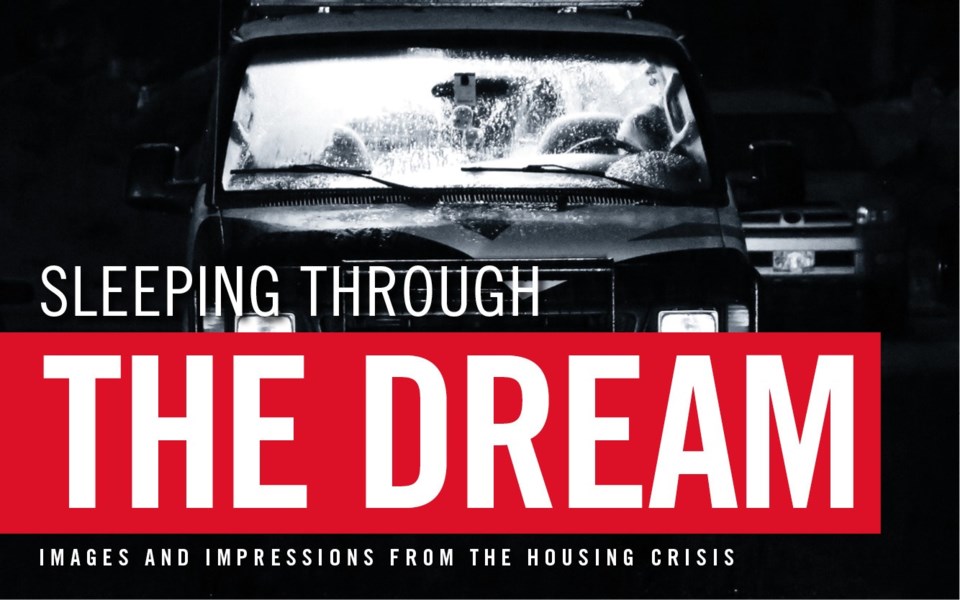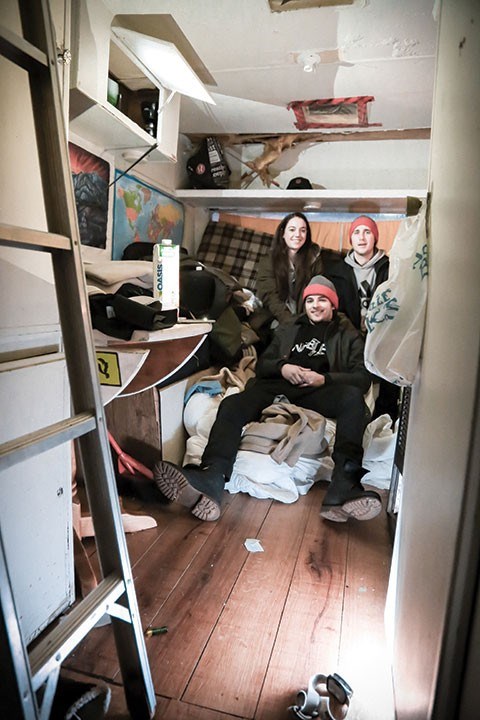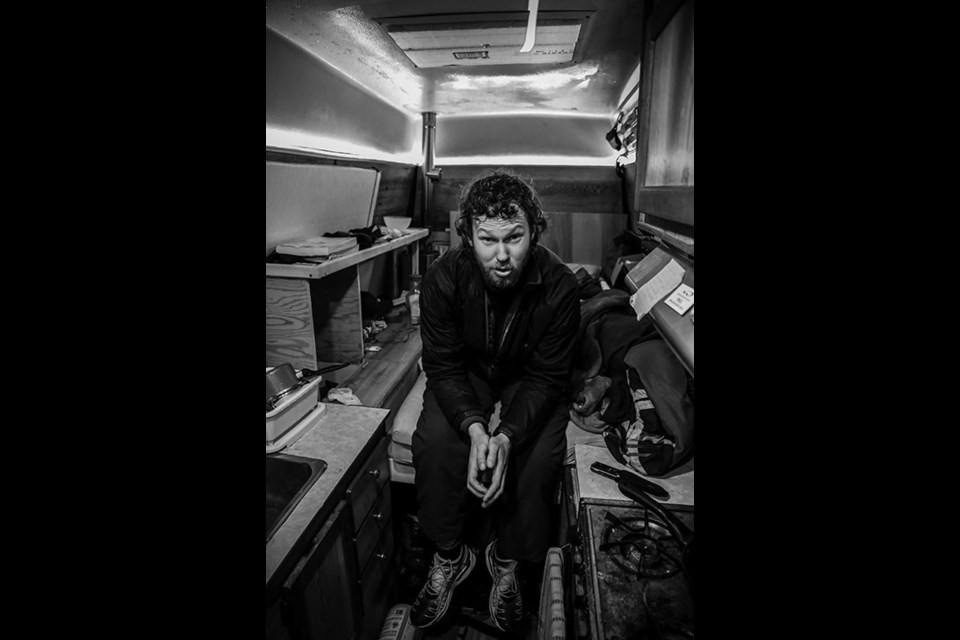
Lights Out in Lot 4

On any given night, some dozen or more RVs and camper vans are huddled under the sentry lights in Whistler’s day lots. Even more are stashed up logging roads or snuggled for the winter into local driveways. Housing takes many shapes and forms in Whistler, and this photo essay is but an impression of a small slice — an attempt to see the macrocosm in the microcosm, and to take a reflective glimpse into a persistent housing crisis that spans from Whistler to the Lower Mainland.
Such transient lifestyles are nothing new. In the mid-‘90s, my best friend lived in a van burrowed deep in a snowbank in the Delta hotel parking lot. He would buy Fresh Tracks tickets — then a $10 dawn buffet with Whistler patrol — and load up Ziploc bags, stuffed into the cargo pockets of his Taiga jacket, with pancakes and scrambled eggs. He likewise perfected the art of sauntering brazenly into hotel hot tubs. His gloves stank so badly we had to hang them on the outside of the gondola. Today, these traditions continue, with consummate ski bums finding their spots for the season. But unlike the ‘90s, when shared housing could be found for most anyone willing to hold down a job, sheer necessity is now driving many full-time staff to the lots.
Australians Kai, Alex, and Grace have made their home in Bertha, a 1978 Dodge Sportsman. “We came together out of homelessness,” says Grace, who works at a local hotel. “We were living together in staff accommodation,” she says, “but we moved out because it was too expensive.” All three use The Core along with hotel facilities. None of them cook. “We eat out all the time,” says Kai. Because the trio receive staff meals and industry discounts, “it’s a lot cheaper to eat out than to buy food,” says Grace.
[slideshow-1]
The Mountains are calling and I Must Go
No winter transient or wandering tourist, Phil B. is a full-time, working professional in Whistler who radiates a quiet confidence. This is his second winter season as a van dweller. His 1984 Dodge B250 XTC camper van, nicknamed Odge, has been purpose built with a marine-grade wood stove, insulated floors and walls, and a custom bed and storage platform. Almost every night he drives out beyond city limits to keep under the radar of bylaw enforcement officers. Like his adjacent van dwellers, the climbing gym The Core is the favoured spot for private showers and towel rentals. Phil makes most of his own food — with staples of burritos and gourmet mac-and-cheese, “as healthy as I can,” he says — while dealing with cold temperatures that freeze fruit and milk. Van dwelling might save some $9,600 a year in rent, but it comes with a social cost — even with his LED mood lighting, it’s hard to share intimacy during the winter months. Phil says there’s “a lot of tension” during winter when van living. He calls it van hate. “If you post up in Lot 4, it’s a bad image, it’s bad for everybody,” he says. He’s also van living out of necessity, not lifestyle. Finding housing is “so hostile in Whistler,” he says. “I don’t have to fight people to find a place. All of my money goes towards saving for a house. I’m not trying to freeload, or cause trouble, or just be a bum or something — I’m just trying to establish myself.” And with an eye to the broader social issues at stake, Phil was invited to speak to Prof. Leanne Roderick’s Quest University class presentation to council on homelessness on Feb. 7.
[slideshow-5]
Sleeping Sound With Glenda
Hailing from Byron Bay, Australia, and hobbling thanks to a minor tear in his knee, Dutchie points out with pride the psychedelic paint job of his bright pink-and-green, 1981 Ford E350 Glendale camper van, nicknamed, of course, Glenda. Dutchie is a working bartender, where he slings Irish fair with Ozzie charm. Along with two friends, he’s renting the driveway of a friend’s house, where he can clean, cook, and “chill out” when he wants to. Glenda’s cozy interior is adorned with posters of mushroom art and a solid sound system, while the outside bears the boyish rallying cry of “Dump ‘Em Out.” Glenda has run the roads from Revelstoke and Banff to Nevada’s Burning Man. The anarchist desert utopia is an ideal community, he says, “where everything works so perfectly.” Not so much the rest of the world. We reflect on how Whistler is changing, and how we both still want a place for the weird. “It’s getting very family orientated, with all these strict rules,” says Dutchie, as he gazes at his Burning Man bikes, frozen in place to Glenda’s brightly painted posterior.
[slideshow-2]
“Are you Living the Dream?”
Carin Smolinski has shot this story with style. For three years, she crawled though camper vans, sandwiched herself into saunas, and ducked under exposed pipes to document what it was like to be “living the dream.” With the onset of the 2010 Olympics, Carin began putting up posters offering six-packs of beer in exchange for photo access to Whistler’s weirdest living spaces — from forest squats and ramshackle huts, to tents dug into trenches. The worst was carbon-monoxide death traps in crawl spaces and paranoia from propane-heater poisoning. Overcrowding was common. Bedding and sheets would be strung up between ceiling rafters to subdivide single rooms. She recalls 17 people living in a two-bedroom unit. “That really killed me,” says Carin, “it was hard to capture the density.” Her solution was to shoot all 17 toothbrushes, brushes touching, crammed into a single glass jar. “One person lived under the stairs, in that tiny space where the furnace is,” says Carin. She once rappelled into a squatter’s shack that had been hammered into the steep trees of the lower mountain. Her later work turned towards families, often crammed into campsites and fifth wheels.
For each shoot she asked her subjects to fill out a questionnaire that today is a sociologist’s treasure trove — and an insight into dangerous dreaming kept alive. “I would ask them, ‘are you living the dream?’” she says. Save for one person, she recalls, the answer was always yes. “The cheaper they could live, the happier they were,” says Carin. Moving back to Whistler a few years ago, it took her months to find a current home for herself and two kids. Carin’s Living the Dream project was exhibited at Millennium Place and published in Ski Journal and the Globe and Mail. She’s now looking for a more permanent home for the collection, and planning to craft the images into a book. Today Carin is a professional photog, shooting family portraits with craft and precision.
[slideshow-3]
If you build it, I will sell it
Departing first the U.K., then North Vancouver, Maggi Thornhill moved to Whistler in the mid-‘80s, and where others saw snow, she saw space. A space for her family, in a “wonderful and small community . . . where the world comes to us.” But also space to sell. And a space to make for herself, as a woman in an industry she describes, at the time, as “very much a boy’s club.” Her first sale made its mark, indeed: it was the highest sale in Whistler at the time, a property worth some $750, 000. “I kind of walked in from nowhere,” she says, and to make the sale, had to “hang the phone up” on the realtor because he gave her “a huge amount of verbal abuse.” Her confidence prompted an immediate callback, and the rest, so to speak, is history. “I’m not intimidated,” says Maggi. At first, she had to deal with industry gossip that she was sleeping around to make sales. But Maggi, who describes herself as a feminist, says “the nice thing about real estate is that it’s so equitable.” Unlike the gendered wage gap in general employment, real estate “is even-Steven.” A sale is a sale, and woman are paid the same as men — on equality of commission.
[slideshow-4]
Out in the cold
This won’t be the last story on Whistler’s housing crisis. The Valley is a microcosm of our finite Earth, and across her four corners the depletion of resources is shifting climate in ways we can scarcely imagine. This story is generational because it is about generations. It is about those born a few generations past, and by providence of birth were able to buy in early; and it is about those who are born later and find themselves, despite full employment, out in the cold. It is a well-worn story, then, about boomers selling homes their children cannot afford. And this story only scratches at the surface of a deeper and unfinished history of Whistler as a settler encampment, squatting on the stolen land of Lil’wat First Nation. The tale of who gets to sleep in, and who has to sleep out, of who is packed in like a rat, and who can swing a cat, will not be over soon.




